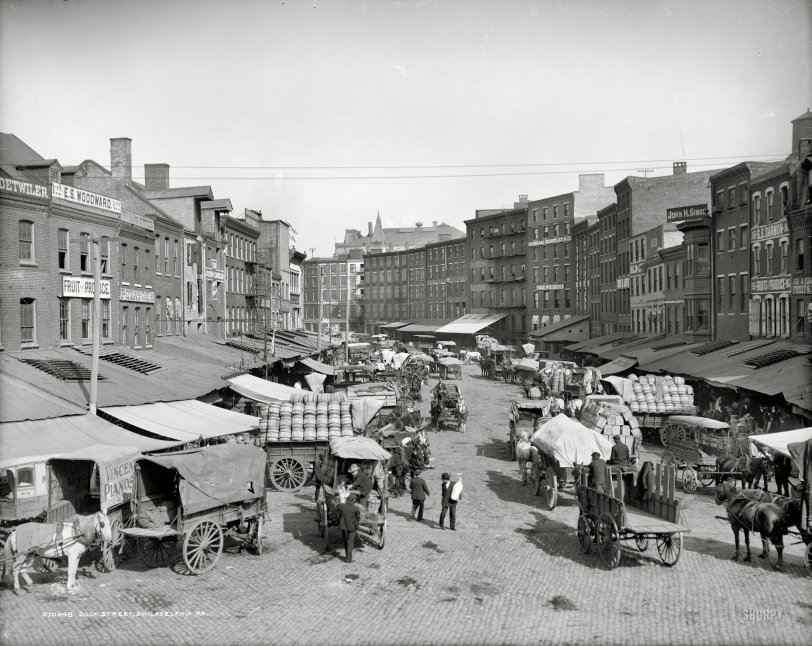


Framed or unframed, desk size to sofa size, printed by us in Arizona and Alabama since 2007. Explore now.
Shorpy is funded by you. Patreon contributors get an ad-free experience.
Learn more.

- Lost in Toyland
- And without gloves
- If I were a blindfolded time traveler
- Smoke Consumer Also Cooks
- Oh that stove!
- Possibly still there?
- What?!?
- $100 Reward
- Freeze Frame
- Texas Flyer wanted
- Just a Year Too Soon
- WWII -- Replacing men with women at the railroad crossing.
- Yes, Icing
- You kids drive me nuts!
- NOT An Easy Job
- I wonder
- Just add window boxes
- Icing Platform?
- Indiana Harbor Belt abides
- Freezing haze
- Corrections (for those who care)
- C&NW at Nelson
- Fallen Flags
- A dangerous job made worse
- Water Stop
- Passenger trains have right of way over freights?
- Coal
- Never ceases to amaze me.
- Still chuggin' (in model form)
- Great shot
Print Emporium
Dock Street: 1908
Food Distribution
This was the main food distribution market in Philadelphia for nearly a century -- a wholesalers market close to the port, not a normal "retail" market like the famous Italian Market in S. Philly. It was destroyed in the 50s-60s urban renewal era when the city built a new food distribution center close to the new container port, near the present Phillies ballpark in S. Philly. Too bad, as it would have made an excellent Faneuil Hall-type of festival marketplace.
The Eternal Question
Curious visitors to the market, trying to peer around the bend in the street, were often heard to ask "What's up Dock?"
Especially on days when the carrot farmers were in town.
Italian Market
Take away the horses and hats and much of this scene still exists along the stretch of Philadelphia's South 9th Street known as the Italian Market. The awning covered market stalls fronting 19th century brick buildings, it's all still there. Plus it is the center of the cheese steak universe.
A bit can be seen here.
Of course this picture was taken after color was discovered.
The movie it reminds me of is...
Public Enemy, starring James Cagney. There's a scene set in 1908 where there are wooden kegs stored in a horse drawn cart just like that one on the left.
Explains the size of the market squares
I love how in Philadelphia you can sort of sniff out the old marketplaces. There's usually a big open space, and the streets come in at angles -- most of the city's large avenues come in at a 45 degree angle to the street grid. Those avenues become the "pikes" which led in and out of the city to the farm areas. Dock Street probably brought a lot more in off the ships, but wherever it came from, I can see that the markets needed a big area to allow the many wagons to turn around and head off on their deliveries.
Up the creek
This is an unusual street by Philadelphia standards, since it does not fit William Penn's original grid plan. In Colonial times it was the site of a creek that in time was paved over, hence the unusual curve.
Looks like a movie set
I was trying to figure out why this looked like a movie set to me, then I realized it is because the curve of the street means that there are no long street vistas (which would be hard to replicate on a movie set). You could almost see a movie begin with this still shot in a grainy sepia, which would then come to life in color - all the teamsters working, horses neighing, men loading and unloading.
The other thing is that it looks earlier than 1908 -- this area of Philly had not changed too much for 40 years or so.
Google Street View - It's ALL Gone, Baby
This is 116 Dock Street, about the same spot as the photo, looking in the same direction.
International Brotherhood
The horse drawn vehicles, especially those with more than one horse, give meaning to the word Teamster as in International Brotherhood of Teamsters. The IBT represents truckers (among others), and even with its questionable past, has over 1 million members.
Hot air
The slats on the awnings are louvers for ventilation. It looks like they have a canvas cover which can be pulled down over them, too.
Stephen
Washington DC
Dock Street Today
Fascinating photo
I am amazed at how many barrels can be put on one wagon. Does anyone know what the slats are on top of the awnings? Are they used to cover the windows?

























On Shorpy:
Today’s Top 5